Produce shoppers can get picky when it comes to choosing the right ripeness of their bananas, a nutritious fruit famous for its high potassium and convenient packaging.
Some people prefer the starchy fiber of green bananas, while others prefer the sweetness of ripe or browning bananas. Many are looking for just the right amount of ripeness in the middle stages. While taste and texture are factors, the health benefits also vary at each stage of ripeness.






